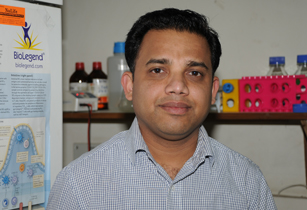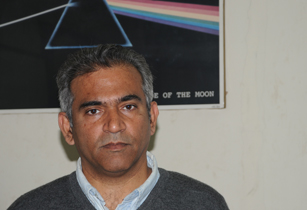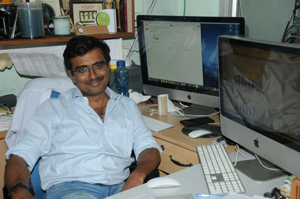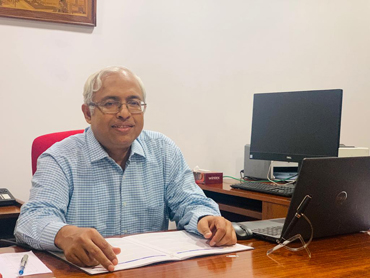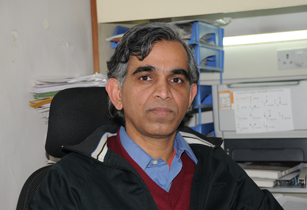सारिका गुप्ता
Neurodegenerative diseases, protein misfolding, inhibitor designing, chronic diseases
Research theme:
My multi-disciplinary group is adopting an integrated approach to drug discovery that combines medicinal chemistry, basic biology, and biochemistry principles for an efficient drug design process. Interests of the group lie in identifying underlying principles in disease pathogenesis to discover new targets, designing molecular intervention strategies, and confirming the biological/therapeutic activities of the designed compounds/formulation. The small molecule/peptide regulators contribute to drug development and the understanding of biological systems in the human body. The pathways and the pathological conditions that we are currently focusing on are:
ER-Stress, Inter-organelle communication and Autophagy
My lab studies mechanisms underlying cellular homeostasis and signalling, focusing on inter-organelle communication with the ER as central and autophagy-lysosome systems. The interest in the ER system in the lab initially emerged through studies to understand how cells respond to different stress conditions. The research group identified ARL6IP5 as a key mediator of ER stress and cellular homeostasis via regulating bulk and selective autophagy via non-canonical pathways, and their role in disease pathogenesis.
My lab uses a holistic approach using different genetic and sporadic animal models to understand disease pathogenesis and cellular models for mechanistic insight. Using quantitative proteomics, imaging, and biochemical approaches to elucidate underlying biochemical mechanisms controlling protein turnover, organelle health, and applying these approaches to examine regulatory pathways relevant to various neurodegenerative diseases, including Prion, Parkinson's and Alzheimer's. A significant focus currently is the ER-associated proteins, which control the turnover of damaged mitochondria via the autophagy pathway and are differentially regulated in Chronic Disease.
Brain-Bone Axis
Altered interorgan signalling contributes to inflammation, particularly in neurodegenerative diseases like Alzheimer's Disease (AD). One emerging axis in this context is brain–bone communication, a bidirectional signalling loop increasingly recognised in ageing and AD pathology. Once thought to be passive, Bone actively participates in this process by releasing osteokines and inflammatory mediators from bone marrow immune cells. These factors can cross the blood-brain barrier (BBB) or influence peripheral immune priming, ultimately impacting brain homeostasis. At the same time, the brain sends signals to the bones. In Alzheimer's and other neurodegenerative diseases, this feedback loop becomes dysregulated, leading to impaired bone integrity, immune dysregulation, and exacerbation of brain inflammation. My lab's interest is in understanding this crosstalk to offer novel therapeutic entry points targeting peripheral organs like the bone to protect the ageing brain.
Bone and Joint Diseases
My lab focuses on the molecular and metabolic basis for skeletal formation and bone and cartilage regeneration. We are focusing on the regulation of bone remodelling in age-dependent and chronic inflammatory conditions. The metabolic regulation of osteoblasts, osteocytes and osteoclasts development and function.
Our foundational research is paving the way for better treatments for skeletal conditions. Our research aims to expand scientific knowledge, ultimately leading to the development of innovative therapies. By uncovering novel insights and validating new therapeutic molecules, we're working toward rationalising new drugs for osteoarthritis and osteoporosis.
Aishwarya Srikant Nilakhe, Moh. Azad, Rakhi Panwar, Arundhati Karmakar, Sumnil Bhola, Harsh Aahra, Harini P, Mushkan Mittal, Jaishree Yadav
Awards:
• 2023-Tata Innovation Fellowship
• 2014: Smt. Kusum Sharma Oration Award, Indian Academy of Biomedical Sciences
• 2013: SERB-DST women excellence award
• 2011: NASI Young scientist award
• 2010: Visiting scientist to University of Miami
Patents:
1. Compound modulating GSK3 activity. USA (Granted Nov 2023)# 11,820764B2
2. Carboxylated osteocalcin for the Treatment of Amyloidosis or diseases associated with abnormal protein folding. India (Granted Dec 2023) # 478376
3. Composition useful for the treatment of inflammatory disease or disorders, 401243, India.
4. Peptide complex with immunomodulatory and anti-inflammatory function, 11,447,534, USA.
5. Peptide complex with immunomodulatory and anti-inflammatory function, 393755, India.
6. Composition useful for treatment of diabetes & disorder, 298991, India.
7. A method for treating metabolic disorders including type-1 and type-2 diabetes mellitus. 8940691, USA.
8. Process for preparing supramolecular calcitonin assemblies (SCA).EP2282763, Europe.
- Viji Vijayan, Ibrar Ahmad Siddique, Sakshi Gupta, Evanka Madan Chopra, Navya Raj, Avadhesha Surolia, Sarika Gupta* (2025). Osteocalcin modulates Abeta42 aggregation to aid in amyloid reduction in mouse models of Alzheimer's disease. Experimental Neurology, 391, 115322, https://doi.org/10.1016/j.expneurol.2025.115322.
- Leena Sapra, Chaman Saini, Pradyumna K. Mishra, Bhavuk Garg, Sarika Gupta, Vikrant Manhas & Rupesh K. Srivastava* (2025). Bacillus coagulans ameliorates inflammatory bone loss in post-menopausal osteoporosis via modulating the “Gut-Immune-Bone” axis, Gut Microbes, 17:1, 2492378, DOI: 10.1080/19490976.2025.2492378
- Betsy Reshma Gilbert, Chirag Miglani, Arundhati Karmakar, Muneesh Pal, Vysakh C. Chandran, Sarika Gupta, Asish Pal, Munia Ganguli*, (2025) A combination of systemic mannitol and mannitol modified polyester nanoparticles for caveolae-mediated gene delivery to the brain, Molecular Therapy Nucleic Acids, Volume 36, Issue 1,2025,102480, ISSN 2162-2531, https://doi.org/10.1016/j.omtn.2025.102480
- Kajal Kamble, Ujjawal Kumar, Harsh Ahara, Mohit, Sumnil Bhola and Sarika Gupta* (2024) A novel ER stress regulator ARL6IP5 induces ER-phagy to ameliorate the prion burden. Autophagy, vol 21, n0. 3, 598-619. https://doi.org/10.1080/15548627.2024.2410670
- Prabhat Upadhyay, Diya Kalra, Aishwarya S. Nilakhe, Vijay Aggrawal, Sarika Gupta* (2023). Polyherbal Formulation PL02 Alleviates Pain, Inflammation, and Subchondral Bone Deterioration in an Osteoarthritis Rodent Model. Front. Nutr. Sec. Nutrition and Metabolism, Volume 10 – 2023. doi: 10.3389/fnut.2023.1217051
- Pal S, G BR, Mohny FP, Choudhury SG, Karmakar A, Gupta S, Ganguli M. Albumin (2023) Nanoparticles Surface Decorated with a Tumor-Homing Peptide Help in Selective Killing of Triple-Negative Breast Cancer Cells. ACS Appl Mater Interfaces. doi: 10.1021/acsami.3c11561.
- Upadhyay P, Tyagi A, Agrawal S, Kumar A, Gupta S*(2023). Bidirectional Effect of Triphala on Modulating Gut-Brain Axis to Improve Cognition in the Murine Model of Alzheimer's Disease. Mol Nutr Food Res. doi: 10.1002/mnfr.202300104.
- Parminder Singh, Kishore Gollapalli, Stefano Mangiola, Daniela Schranner, Mohd Aslam Yusuf, Manish Chamoli, StingL.Shi, Bruno Lopes Bastos, TriptiNair, Annett Riermeier, Elena M. Vayndorf, JudyZ.Wu, Aishwarya Nilakhe, ……., Sarika Gupta, Vidya Velagapudi, Anthony T. Papenfuss,Alaattin Kaya, Miguel Godinho Ferreir, Brian K. Kennedy, Julie K. Andersen,Gordon J. Lithgow, Abdullah Mahmood Ali, Arnab Mukhopadhyay, Aarno Palotie, Gabi Kastenmüller, Matt Kaeberlein, Henning Wackerhage, B. Hupinder Pal, Vijay K.Yadav* (2023). Taurine deficiency as a driver of aging. Science 380, eabn9257.
- Ibrar Siddique, Kajal Kamble, Sakshi Gupta, Kavita Solanki, Sumnil Bhola, Nuzhat Ahsan, Sarika Gupta * (2023). ARL6IP5 ameliorated synuclein burden by inducing autophagy viapreventing ubiquitination and degradation of ATG12. Int. J. Mol. Sci. 24(13), 10499.
- Ramakrishna Voggu, Arundhati Karmakar, Venkat Swamy Puli, V. Surendra Babu Damerla, Padma Mogili, P. Amaladass, Sridhar Chidara *, Kalyan Kumar Pasunooti *, Sarika Gupta * (2023). Design, Synthesis, Molecular Docking Study and Biological Evaluation of Novel γ-Carboline Derivatives of Latrepirdine (Dimebon) as Potent Anticancer Agents. Molecules 28(13), 4965.
- Mayuri Khandelwal, Kapil Manglani, Prabhat Upadhyay, Mohammad Azad, Sarika Gupta* (2022) AdipoRon induces AMPK activation and ameliorates Alzheimer’s like pathologies and associated cognitive impairment in APP/PS1 mice. Neurobiology of Disease 174, 105876
- Girija Shankar Papanai, Krishna Rani Sahoo, Betsy Reshma G, Sarika Gupta, and Bipin Kumar Gupta (2022). Role of processing parameters in CVD grown crystalline monolayer MoSe2. RSC Adv., 12, 13428.
- Girija Shankar Papanai, Samanta Pal, Prabir Pal, Brajesh S. Yadav, Preeti Garg, Sarika Gupta, S. G. Ansari, and Bipin Kumar Gupta (2021). New insight into the growth of monolayer MoS2 flakes using an indigenously developed CVD setup: a study on shape evolution and spectroscopy. Mater. Chem. Front., 5, 5429-5441.
- Khan J, Salhotra S, Goswami P, Akhtar J, Jahan S, Gupta S, Sharma S, Banerjee BD, Parvez S, Gupta S*, Raisuddin S* (2019). Bisphenol A triggers axonal injury and myelin degeneration with concomitant neurobehavioral toxicity in C57BL/6J male mice. Toxicology, Dec 1;428:152299.
- Manglani K, Vijayan V, Pathak C, Khandelwal M, Singh P, Chellappa S, Yadav VK, Surolia A, Gupta S*(2019). Development and characterization of supramolecular calcitonin assembly and assessment of its interactions with the bone remodelling process. Bone, Feb 21;122:123-135.
- Khan J, Salhotra S, Ahmad S, Sharma S, Abdi SAH, Banerjee BD, Parvez S, Gupta S*, Raisuddin S*(2018). The protective effect of α-lipoic acid against bisphenol A-induced neurobehavioral toxicity. Neurochem Int. Sep;118:166-175.
- Ahsan N, Siddique IA, Gupta S*,Surolia A*(2018). A routinely used protein staining dye acts as an inhibitor of wild type and mutant alpha-synuclein aggregation and modulator of neurotoxicity.Eur J Med Chem. Jan 1;143:1174-1184.
- Viji Vijayan, Sakshi Gupta Sarika Gupta* (2017). Bone morphogenetic protein-5, a key molecule that mediates differentiation in MC3T3E1 osteoblast cell line. Biofactors, May 12. doi: 10.1002/biof.1360.
- Viji Vijayan and Sarika Gupta* (2017). Role of Osteocytes in Mediating Bone Mineralization during Hyperhomocysteinemia. Journal of Endocrinology, Jun;233(3):243-255.
- Chattopadhyay T., Ranjan R., Gupta S*, Surolia A* (2017). Bone morphogenetic protein-7 (BMP-7) augments insulin sensitivity in mice with type II diabetes mellitus by potentiating PI3K/AKT pathway. Biofactors, Mar;43(2):195-209.
- Pal M, Gupta S* (2017). Testosterone supplementation improves glucose homeostasis despite increasing hepatic insulin resistance in male mouse model of type 2 diabetes mellitus. Nutrition & Diabetes, Dec 12;6(12):e236.
- Ahsan N, Mishra S, Jain MK, Surolia A, Gupta S* (2015). Curcumin Pyrazole and its derivative (N-(3-Nitrophenylpyrazole) Curcumin inhibits aggregation, disrupt fibrils and modulate toxicity of Wild type and Mutant α-Synuclein. Sci Rep. May 18;5:9862.
- Pasi S, Kant R, Gupta S, Surolia A (2015). Novel multimeric IL-1 receptor antagonist for the treatment of rheumatoid arthritis. Biomaterials. Feb;42:121-33.
- Pathak C, Ranjan Singh R, Yadav S, Kapoor N, Raina V, Gupta S*,Surolia A* (2014). Design, synthesis and biological evaluation of benzothiophene carboxamide derivatives as analgesics and anti-inflammatory agents. IUBMB Life, Mar 26.
- Vijayan V, Khandelwal M, Manglani K, Gupta S*, Surolia A* (2014). Methionine down-regulates TLR4/MyD88/NF-κBsignalling in osteoclast precursors to reduce bone loss during osteoporosis. Br J Pharmacol. Jan;171(1):107-21.
- Vijayan V, Khandelwal M, Manglani K, Singh RR, Gupta S*, Surolia A* (2013). Homocysteine alters the osteoprotegerin/RANKL system in the osteoblast to promote bone loss: pivotal role of the redox regulator forkhead O1. Free RadicBiol Med. Mar 15;61C:72-84.
- Gupta S, Chattopadhyay T, Pal Singh M, Surolia A (2010). Supramolecular insulin assembly II for a sustained treatment of type 1 diabetes mellitus. Proc Natl Acad Sci U S A. Jul 27;107(30):13246-51.
- Sarika Gupta, Manmohan Chhibber, Sharmistha Sinha, AvadheshaSurolia, (2007). Design of Mechanism Based Inhibitors of Transthyretin Amyloidosis: Studies with Biphenyl Ethers and Novel Structural Templates. Journal of Medicinal Chemistry.50(23):5589-99.









